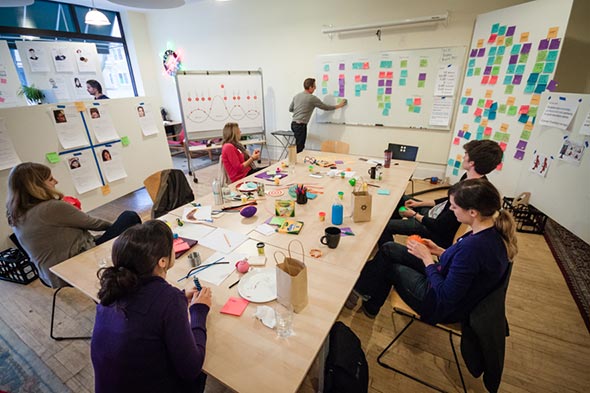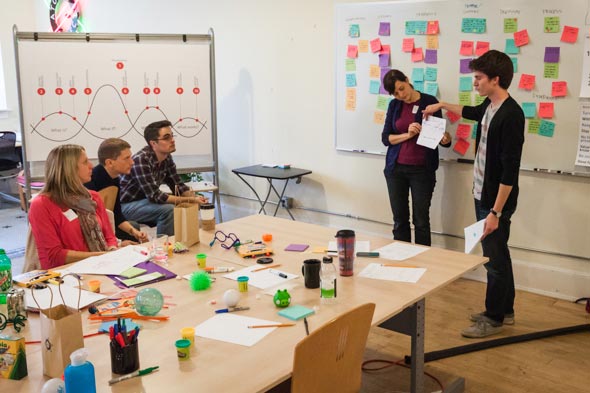In developing an online product, it can be difficult to maintain perspective on the overall purpose and user experience. When and if you run out of ideas, take time to get out and test your assumptions by bringing in an outside source.
On our product team, we recently reached a point in development where we wanted to get some fresh perspective. We were almost a year and a half into development on the application. But we were about ready to embark on creating a new feature in the app, and a lot of time had passed since our original concepts, so we decided to brainstorm with several people from inside and outside of the industry in which our app is used.

Brainstorming isn’t always easy. It can be messy collecting the information and deciphering which way to go when you’re done. Therefore, we drew from a brainstorming process entitled Focused Innovation Technique (F.I.T) for our session to facilitate the best outcome.
From the website:
“The F.I.T. encourages groups to be creative while building on each other’s expertise in a high-energy process that promotes team spirit and the alignment necessary to support implementing the results. Innovation Project Design helps you to target the right challenges in the right way.”
Our brainstorm process using this technique was comprised of 3 main stages:
- I wish…
- I could…
- Concept sheets
The whole session lasted about 3 hours. We kicked it off by receiving a lot of great input from our research team. The results were posted on the walls surrounding us, including important facts, quotes, pictures, personas, journey maps, and the main problem (or challenge) we were trying to solve.
We included members of the development team, the product owner, and a few people from various related organizations. Our table was outfitted with plenty of colorful hands-on toys, craft supplies, stickies, markers, paper, and play dough — essential tools to help get our minds ready to crank out ideas.
Stage 1: I wish…
During this section, participants brainstorm as many ideas as possible in 6 minutes. The only stipulation is that each idea must begin with the statement “I wish…” in order to frame it. Write down any idea that comes to mind related to solving the real world problem a person faces around the “challenge”. For instance, “I wish there was an easy way to see what it’s like working as a mechanic.”
Generate ideas like this quickly. Work independently, keeping one idea per sticky note. At the end of the time limit, quickly share your ideas with the group and place them on the wall. As they go up, the facilitator loosely categorizes the stickies on the wall. After everyone has presented, each person votes for their favorite ideas using something like dot voting.
Choose the top few ideas and put them aside for use in the next stage.
Stage 2: I could… (how it might work)
The second stage of our process is to do another round of brainstorming, this time using the phrase “I could…”.
During this stage, the ideas from stage one begin to take shape in more concrete ways. Take the most popular ideas from stage one and hang them across the top of the wall to allow people to refer to them as they generate ideas.
Take 6 minutes to brainstorm ways you could accomplish the wishes from Stage 1. For example: “I could spend a day on the job with someone in the field.”
Present and vote on this round of ideas just like the previous one.
Stage 3: Concept Sheets
After steps one and two, the ideas are starting to gel. It’s fun to watch how things start to come together in this step.
Pick the top 3 ideas from the previous session. Get in groups of two to write down a simple one-page explanation for 1 or 2 of the ideas, to outline the following:
- What’s the idea?
- How might it work?
- Plusses
- Concerns
Then, each group presents their idea(s) to the rest of the group in brief presentations.
If it helps communicate the idea, include sketches and a fun, catchy name and sketches. At this stage, ideas for how software could help start to appear. But software isn’t always the best or only solution to a concept. In fact, this process shows opportunity for solutions that may be cheaper than a software solution.

Through this effective process, we found this process of divergent thinking to help us get 3-4 very solid concepts on how to reach our audience effectively.
A few brainstorming tips:
- Hang up a clear schedule of the day, and go over it at the beginning.
- Prominently display the rules about the brainstorm session — for example, keep an open mind, value what you don’t know, be courageous, turn off cell phones, and have fun!
- This Innovation Management article on 25 strategies for high-impact brainstorming sessions was also helpful.
What experiences have you had in brainstorming? What tips do you have?

Coincedentally I’m currently reading Quiet:The Power of the Introvert and it has a section on Brainstorming and says it’s not as effective as people think. This New Yorker article – http://www.newyorker.com/reporting/2012/01/30/120130fa_fact_lehrer – goes into more depth and has a quote:
” Decades of research have consistently shown that brainstorming groups think of far fewer ideas than the same number of people who work alone and later pool their ideas. ”
Does your experience show that brainstorming works ?
Thanks for the link, Phil. I agree, there can be problems with group think in brainstorming and have encountered this personally. However, I also think this particular brainstorm method can still generate a lot of great ideas. Brainstorming with the right people can also foster buy in from the constituents. A great move when you’re working with a large team or enterprise.
Coming out of this session, the client and I were inspired to collaborate and jot down 2 very solid ideas. Additionally, there were several insights spoken during the brainstorm session that weren’t previously identified.